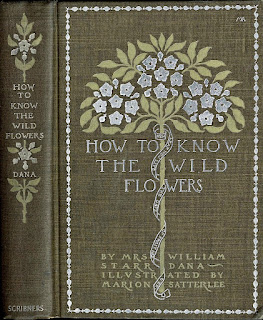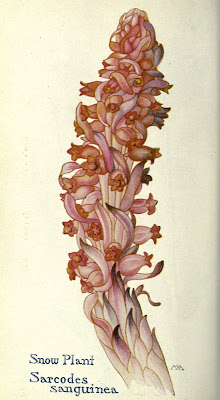 |
|
Margaret Armstrong often used plant motifs, in this case the Coast Range Mariposa Lily (1); source.
|
By 1913, American graphic artist Margaret Armstrong had all but abandoned her successful career in cover design. It's true that Art Nouveau, whose flowing undulating lines she found so inspiring, was falling out of fashion, and that cheaper printed paper dust jackets were replacing decorative covers. But these trends were largely coincidental. Armstrong gave up her career for a very different reason. She was writing a book about her passion—the wildflowers of the American West.
Margaret Neilson Armstrong was born in New York in 1867 to a wealthy and artistic family. Her father, a diplomat, studied oil painting while in Italy, and also worked in stained glass, as did her sister Helen. Margaret started her career as a graphic designer in the 1880s, and by 1890 was specializing in book covers and bindings. She produced covers in her popular distinctive style for at least 270 books, including works by well-known authors such as Washington Irving, Henry Thoreau, Henry Van Dyke and John Greenleaf Whittier, as well as the popular botany books of Francis Theodora Parsons (aka Mrs. William Starr Dana).
Armstrong continued to travel the western United States—studying, sketching and collecting wildflowers. None of the existing field guides adequately covered the area west of the Rocky Mountains (4), and she was eager to produce one herself. But as she noted, “the field is vast, including within its limits all sorts of climate and soil, producing thousands of flowers, infinite in variety and wonderful in beauty, their environment often as different as that of Heine's Pine and Palm” (quotes here and below are from Armstrong's Field Book). Out of this multitude, she chose some 550 of the more common species for her book—from Washington, Oregon, Idaho, California, Nevada, Utah and Arizona.
Pride of California, Lathyrus splendens, “has such glorious flowers, so superb in color and form, that it is by far the handsomest of its kind and not to be mistaken for any other.” (Metropolitan Museum of Art)
 |
|
Armstrong family c. 1910s; Margaret lower right (source).
|
 |
|
Armstrong marked her covers with the monogram “MA” (upper right corner). Winding banner reads: "New leaf, new life, the days of frost are o’er" (source).
|
By 1908, Armstrong’s output began to decrease noticeably as she devoted more and more time to her passion for plants. This wasn't terribly surprising to those who knew her, for she had been an enthusiastic naturalist since childhood (2). Things got exciting in 1911, when Armstrong (then in her mid-forties) and three gal friends toured the American West, seeking adventure as well as plants. They rode horses down into the Grand Canyon, and crossed the Victoria Glacier above Lake Louise to climb to the Mitre Col (see her 1912 article). While they weren’t the first women to accomplish these things (3), they were operating far outside the norm, and enjoyed themselves immensely for it.
“We found the rope very much in our way, but we saw the necessity of it when we came to a crevasse: a wonderful, shining, blue-green crack, its walls fringed with icicles, cleft in the bosom of the glacier. It was a long, dizzy step across …”
Armstrong continued to travel the western United States—studying, sketching and collecting wildflowers. None of the existing field guides adequately covered the area west of the Rocky Mountains (4), and she was eager to produce one herself. But as she noted, “the field is vast, including within its limits all sorts of climate and soil, producing thousands of flowers, infinite in variety and wonderful in beauty, their environment often as different as that of Heine's Pine and Palm” (quotes here and below are from Armstrong's Field Book). Out of this multitude, she chose some 550 of the more common species for her book—from Washington, Oregon, Idaho, California, Nevada, Utah and Arizona.
Field Book of Western Wild Flowers was published in 1915 (available online here). At first glance it might appear academic. It's organized by family, and includes a technical family key, genus as well as species descriptions, and a glossary of technical terms. Both common and scientific (Latin) names are used, the latter following accepted nomenclature of the time (5). Species descriptions address all relevant characters.
Yet Armstrong intended the guide to be “mainly for the general public.” Toward that end, it was “fully illustrated” with 500 line drawings and 48 color paintings, all done by Armstrong from live specimens. And she didn’t restrict herself to dry technical descriptions. She added vignettes about the beauty, oddness, enchantment, and even danger that one might encounter in meeting these wildflowers.
Let's look at some of her chosen subjects (images from BHL Western Wild Flowers Flickr album unless noted):
Let's look at some of her chosen subjects (images from BHL Western Wild Flowers Flickr album unless noted):
White Evening Primrose, Pachylophus marginatus, is today’s Oenothera cespitosa. “There is a patch of these wonderful flowers in the Grand Canyon on Bright Angel trail, halfway between the rim and the plateau, where in a shaded spot beside a great rock the pure blossoms seem to shed a moonlight radiance.”
Yellow Avalanche Lily, Erythronium grandiflorum, was also called Dogtooth Violet in Armstrong’s day. “A patch of these flowers bordering the edge of a glacier, as if planted in a garden-bed, is a sight never to be forgotten. Pushing their bright leaves right through the snow they gayly swing their golden censers in the face of winter and seem the very incarnation of spring.”
 |
|
Erythronium grandiflorum pushing "right through the snow" (source).
|
Armstrong's Bi-colored or Parti-colored Lupine, Lupinus stiversii, is now called Harlequin Lupine. “One of the prettiest and most conspicuous kinds [of lupines], for its coloring is unusual … fragrant flowers, over half an inch long, with rose-colored wings and a yellow standard, changing to orange in fading. The combination of pink, orange, and yellow is very striking.”
 |
|
Lupinus stiversii (source).
|
Snow Plant, Sarcodes sanguinea, is “a strange plant, widely celebrated for its peculiar beauty … The plants are shaded with red all over, from flesh color, to rose, carmine, and blood-red, and are translucent in texture, so that when a shaft of sunlight strikes them they glow with wonderful brilliance, almost as if lighted from within. …They are pointed out to tourists by Yosemite stage drivers, but the government forbids their being picked, for fear of extermination.”
Indian Pipe, Monotropa uniflora, is “all translucent white, beautiful but unnatural, glimmering in the dark heart of the forest like a pallid ghost, mournfully changing to gray and black as it fades” (source).
 |
|
Monotropa uniflora (source).
|
Armstrong was quite impressed by this cholla, Opuntia fulgida—now called jumping or chain fruit cholla, Cylindropuntia fulgida. “A horrible shrub, or dwarf tree … The distant effect of this plant is a pale, fuzzy mass, attractive in color, giving no hint of its treacherous character more like a wild beast than a plant! The joints suggest a very ferocious chestnut-burr and break off at a touch, thrusting their spines deeply into the flesh of the unwary passer-by, so that the Indian story, that this plant flings its darts at wayfarers from a distance, might almost as well be true, and the barbs making the extraction difficult and painful.” (source).
 |
|
Cylindropuntia fulgida (source).
|
I learned of Margaret Armstrong and her wildflower book only recently, by way of Flickr where the color plates have been uploaded by Biodiversity Heritage Library. They’re available for download, are copyright-free, and have been tagged (partly by yours truly) so that they will come up in searches (scientific name, common name, artist name and more). If you’re looking for a fascinating citizen science opportunity, checkout BHL on Flickr for more information.
Notes
(1) The Coast Range Mariposa Lily, Calochortus vestae, was C. luteus var. oculatus in Armstrong’s day. She considered mariposa lilies to be the most characteristic flowers of the West. “They grow freely all through the West, as far north as British America, and down into Mexico, but they never get east of Nebraska, so these gay and graceful flowers may be considered the peculiar property of the West.” C. vestae was “one of the most beautiful of all the Mariposas.”
Notes
(1) The Coast Range Mariposa Lily, Calochortus vestae, was C. luteus var. oculatus in Armstrong’s day. She considered mariposa lilies to be the most characteristic flowers of the West. “They grow freely all through the West, as far north as British America, and down into Mexico, but they never get east of Nebraska, so these gay and graceful flowers may be considered the peculiar property of the West.” C. vestae was “one of the most beautiful of all the Mariposas.”
(2) Armstrong had no formal training in botany.
(3) Armstrong and her companions are sometimes referred to as the first white women to reach the bottom of the Grand Canyon. But from her account of the trip, it’s clear that others had gone before. She included a story told by their guide of a female tourist who refused to ride back up to the rim, and had to be hauled out on a litter.
(4) In her Preface, Armstrong states that hers “is the only fully illustrated book of western flowers, except Miss Parsons's charming book, which is for California only” (Wild Flowers of California by Mary Elizabeth Parsons, 1900). She doesn’t mention Rocky Mountain Flowers by Frederic and Edith Clements, published in 1914—possibly too late to be noted in her book. In any case, Armstrong didn't include species found only in the Rockies.
(5) Armstrong recruited a small army of botanical experts for help with identification and nomenclature. In her acknowledgements, she noted that “Professor J. J. Thornber, of the University of Arizona, is responsible for the botanical accuracy of the text and his knowledge and patient skill have made the book possible.” She thanked eight experts on the flora of the western United States for “most valuable assistance in the determination of a very large number of specimens …” and eight others for advice and assistance (including luminaries such as Alice Eastwood, WL Jepson, Marcus Jones and NL Britton).
Sources
Armstrong, Margaret. 1912. “Canyon and Glacier” in The Overland Monthly ser. 2 v. 59. Available here courtesy HathiTrust.
Armstrong, Margaret. 1915. Field book of western wild flowers. London,C. [sic] P. Putnam's Sons. Available here courtesy Biodiversity Heritage Library.










Oh yes, what a joy to see these! I so enjoy her story. Thanks for sharing some fascinating details about her life.
ReplyDeleteThank you, Beth – glad you enjoyed it!
Deletesplendid
ReplyDeleteThanks, Alex :)
DeleteGreat writing! Good to find out about Mrs. Armstrong.
ReplyDeleteThe sight of skirt dressed women climbing over the snow made me smile :)
And after all, how many women do this nowadays? I know some are but not to the extent that the different times would allow it.
I thought about you while up in SE BC mountains in a place with most amazing rocks. A knowledgeable guide would have been great!
Thanks, Gabriela. I got such a kick out of those photos too -- it is hard to imagine mountaineering in long skirts, jumping across crevasses, and in heavy hob-nailed boots!
Delete